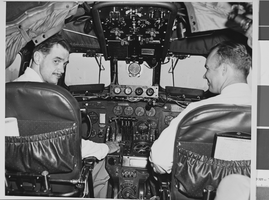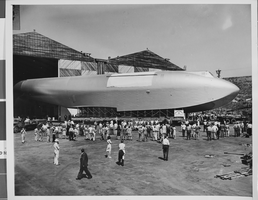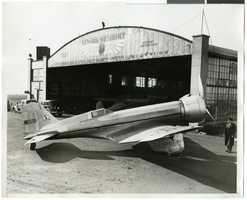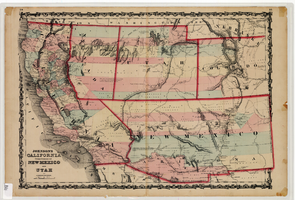Search the Special Collections and Archives Portal
Search Results
Wilbur Clark at a formal dinner, New York City, New York, 1958
Level of Description
File
Archival Collection
Toni and Wilbur Clark Photographs
To request this item in person:
Collection Number: PH-00302
Collection Name: Toni and Wilbur Clark Photographs
Box/Folder: Folder 10
Collection Name: Toni and Wilbur Clark Photographs
Box/Folder: Folder 10
Archival Component
Watercolor sketches: Central Park, New York City, New York, undated
Level of Description
File
Archival Collection
Jeanne Russell Janish Papers
To request this item in person:
Collection Number: MS-00355
Collection Name: Jeanne Russell Janish Papers
Box/Folder: Oversized Box 16
Collection Name: Jeanne Russell Janish Papers
Box/Folder: Oversized Box 16
Archival Component

Photograph of Howard Hughes installing radar, Culver City, California, May 03, 1947
Date
1947-05-03
Archival Collection
Description
Description given with photo: "Hughes Pilots Radar-Equipped Plane Culver City, Calif. -- First passenger plane equipped with radar is flown in demonstration May 1st by Howard Hughes (left) and co-pilot R.C. Loomis over Culver City. Pilots using this equipment will be warned of approaching obstacles by lights flashing on radar panel. Two lights (lefts) with 2,000-foot range, are used to guarantee clearance over mountains; two lights (right) with 500-foot range, are a safety device for approaches and landings. Either set of lights warns against approaching aircraft. Trans-World Airline plans to install radar on its passenger planes. Credit (ACME) 5-3-47."
Image
Howard Hughes, Los Angeles, California Security Pacific tri-party agreement, 1985 July 01 to 1986 November 15
Level of Description
File
Archival Collection
Thomas L. Morgan Real Estate Development Records
To request this item in person:
Collection Number: MS-01091
Collection Name: Thomas L. Morgan Real Estate Development Records
Box/Folder: Box 02
Collection Name: Thomas L. Morgan Real Estate Development Records
Box/Folder: Box 02
Archival Component

Photograph of Howard Hughes' Hercules, Culver City, California, June 16, 1946
Date
1946-06-16
Archival Collection
Description
Description given with photo: "Hercules Fuselage Leaves Hangar, Calver City, Calif. - The hull of Howard Hughes' huge cargo flying boat, the Hercules, largest airplane in the world leaves hangar in the Culver City, Calif., plant to begin a 28-mile trip to Terminal Island, Calif., by truck and dolly. the 220-foot long hull-fuselage will follow the path of the wing sections to the graving dock where the air giant will be assembled. Credit Line (ACME) 6/16/46."
Image
View of New York City from New Jersey: color slide, 1943
Level of Description
Item
Archival Collection
Larry Fotine Music collection
To request this item in person:
Collection Number: MS-01179
Collection Name: Larry Fotine Music collection
Box/Folder: Digital File 00
Collection Name: Larry Fotine Music collection
Box/Folder: Digital File 00
Archival Component

Photograph of Howard Hughes' Northrop Gamma Racer in Newark, New Jersey, January 14, 1936
Date
1936-01-04
Archival Collection
Description
A view of the side of Howard Hughes' Northrop Gamma Racer.
Image

Photograph of Howard Hughes and Edmund T. Allen, Seattle, Washington, July 7, 1938
Date
1938-07-07
Archival Collection
Description
Description given with photograph: "Howard Hughes tests the Hughes plane. Seattle--Howard Hughes (right), millionaire aviation enthusiast and record holder, shown with Edmund T. Allen, Boeing test engineer, before they made a recent test flight in a Boeing-built Stratoliner. The huge machine was equipped with extra fuel tanks for the test. Hughes did not reveal the reasons for his interest in the four-motored, 30 passenger plane, designed for substratosphere flight."
Image
New York Mine, Silver City, Nevada
Level of Description
File
Archival Collection
Mary Griffith Toleno Photograph Collection
To request this item in person:
Collection Number: PH-00021
Collection Name: Mary Griffith Toleno Photograph Collection
Box/Folder: N/A
Collection Name: Mary Griffith Toleno Photograph Collection
Box/Folder: N/A
Archival Component

Map of California and territories of New Mexico and Utah, circa 1861
Date
1859 to 1862
Description
'Compiled, drawn, and engraved under the supervision of J.H. Colton and A.J. Johnson.' Relief shown by hachures and spot heights. Scale [ca. 1:3,041,280]. 1 in. to approx. 48 miles (W 124°--W 103°/N 42°--N 31°). Hand colored
Prime meridians: Greenwich and Washington
Plates 54 & 55 removed from Johnson's New illustrated family atlas of the world, with descriptions geographical, statistical and historical ... New York, 1862
Title page of atlas.
Prime meridians: Greenwich and Washington
Plates 54 & 55 removed from Johnson's New illustrated family atlas of the world, with descriptions geographical, statistical and historical ... New York, 1862
Title page of atlas.
Image
Pagination
Refine my results
Content Type
Creator or Contributor
Subject
Archival Collection
Digital Project
Resource Type
Year
Material Type
Place
Language
Records Classification
